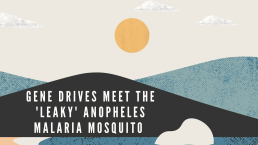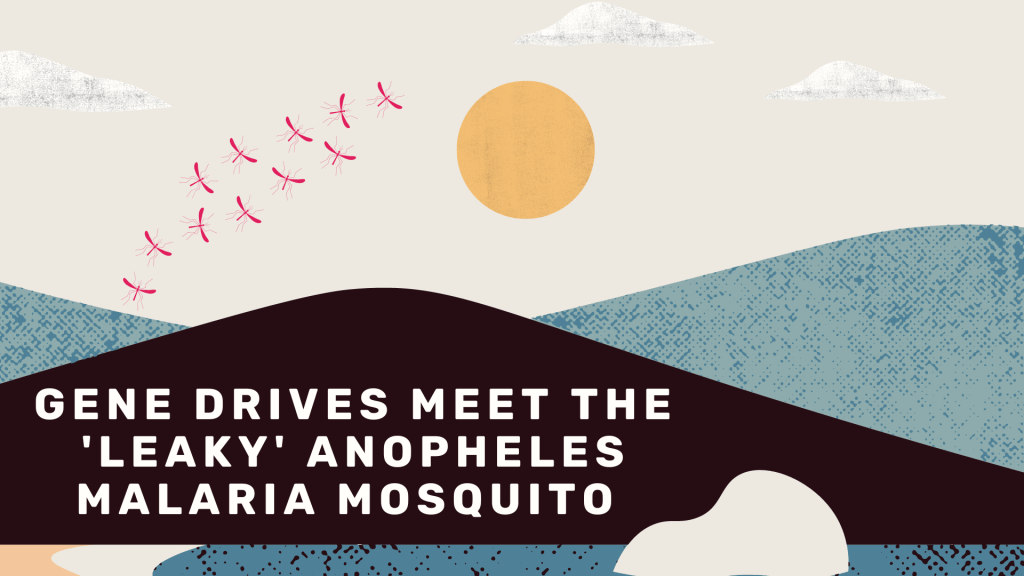Can gene drives spread between mosquito species?
The issue of Malaria in Africa has for a long time been at the forefront of the discussion about gene drive technology. Leading the research is Target Malaria, a non-profit aimed at using genetic means to eliminate malaria. However, despite the initial success in their laboratory studies, there are glaring open questions and unknowns around releasing gene drive Anopheles gambiae sensu strictu mosquitoes into the environment.
High on the list of concerns are the ecological effects. The risk to an ecological system is considerable when we are talking of eliminating just one species. However Anopheles gambiae sensu strictu is just one member of at least nine mosquito species in the ‘Anopheles gambiae complex’ (known as A. gambiae sensu lato, i.e ‘in the wider sense’), a family of mosquito species that look identical and are well-known to interbreed and produce young hybrids that are capable of breeding1. This has already been troublesome for the fight against malaria as it has been shown to lead to the exchange of mutations that help the survival of species within the complex. For example, Anopheles arabiensis acquired genes that make it resistant to dry and arid conditions through A. gambiae s.s and A. coluzzi, and A. coluzzi acquired a gene for insecticide resistance through A. gambiae s.s2,3,4. In the context of a gene drive, which actively forces inheritance of a chosen gene upon all its offspring, the consequences of the exchange of genes between species is even more concerning.
The real risk comes when the target of the gene drive is taken into account. The doublesex gene is an essential gene for sexual development, and thus the disruption of it means females develop into intersex, infertile adults that cannot reproduce5. Breeding rates drop drastically, and the population crashes. Because of its vital importance to mosquito survival, the gene is called ‘highly conserved’- this means natural selection puts a strong pressure on it remaining unchanged. This is useful to the development of a gene drive as it means that less genetic ‘resistance’ develops and the gene drive is more likely to spread without problems. However, it turns out that this gene is so vital to insect development that it remains almost identical in sequence across the whole Anopheles complex (and even across all insects ever investigated for the gene, making interspecies spread through horizontal gene transfer a further risk)6. This identical genetic target, together with the fact of interbreeding, means there is no barrier remaining preventing the gene drive potentially spreading and crashing all 9 species of the A. gambiae complex in Africa. Six of the species under threat play either no or only minor roles in malaria transmission- just the three species A. gambiae sensu strictu, A. coluzzi and A. arabiensis are considered to be major vectors of malaria7,8.
From the linear, simple perspective of malaria control, it could be argued that this is beneficial- why risk it and leave any possibility that other A. gambiae complex species could take over the role of A. gambiae s.s in transmitting malaria? This concern is justified as the replacement of one vector with another has occurred at least once, with Anopheles funestus being replaced with Anopheles rivolurum after the habitat was sprayed with insecticide in rural Tanzania9. However, from an ecological perspective, the elimination of the whole A. gambiae species complex could imply ecological catastrophe. A recent landmark study demonstrated that the alteration of even one gene in a plant that insects rely on can significantly increase the likelihood of insect extinction10. If the alteration of even one gene can have a detrimental impact on biodiversity, it leads naturally to the question of what happens when 9 species are eliminated.
There is an incredible lack of research on the ecological role of A. gambiae, and the little there is seems to be mostly from Target Malaria themselves. To carry out a risk assessment that is in any way close to satisfactory for a gene drive, this ought to be the first priority. However the few studies there are demonstrate an important ecological role of mosquitoes; one study Target Malaria published showed that around 95% of the larvae of the A. gambiae complex are eaten before they develop11. Furthermore, a recent study showed that the number and diversity of birds and dragonflies were reduced following the use of a biological insecticide12. Pollination, vital for the ecosystem, is also at risk; as well as being prey for other insects and birds that are pollinators, Anopheles mosquitoes also need sugar to survive. Mosquitoes actually need to feed on sugar through feeding on nectar more frequently than they do on blood. This behaviour may also play a direct role in pollinating13.
Target Malaria recently made the step of acknowledging the spread of their gene drive to other mosquito species14. However, the central concern of the blog and paper seems to be little more than a game of wordplay and regulatory chess regarding how to define the ‘target organism’ for the purposes of making the risk assessment less complicated. Almost unmentioned in this was the ecological risk; the potential ecological destruction that might ensue as a result of the release of a gene drive being let loose into a ‘leaky’ mosquito species complex.
This question must be taken seriously by developers and regulators. Malaria is indeed a serious issue, but risking the effects of environmental collapse on local populations with a direct reliance on a healthy, resilient ecosystem, could be equally or more deadly. However, due to the impossibility of trialling gene drive organisms in the wild before their official release, the extent of this risk could be overlooked until it is too late. The very nature of their design dictates that any release could result in their unfettered spread, due to the ‘genetic chain-reaction’ that ensues. The current methods suggested to reverse gene drives are entirely theoretical, untested and therefore insufficient to use to remedy the situation should the need arise.
This acknowledgement of the likely spread of the gene drive and subsequent crash of the A. gambiae complex should lead to serious questions around whether this is a safe, reasonable avenue to pursue in the fight against malaria. This risk is just one of many in the story of gene drives and is a neglected area of research. These unanswered questions have led us and many others to call for a global moratorium on the release of gene drives until these risks have been satisfactorily ruled out. To read more on our policy recommendations, click here.
1,6,14John B. Connolly, Jörg Romeis, Yann Devos, Debora C.M. Glandorf, Geoff Turner, Mamadou B. Coulibaly, Gene drive in species complexes: defining target organisms, Trends in Biotechnology, 2022
2Barrón MG, Paupy C, Rahola N, Akone-Ella O, Ngangue MF, Wilson-Bahun TA, Pombi M, Kengne P, Costantini C, Simard F, González J, Ayala D. A new species in the major malaria vector complex sheds light on reticulated species evolution. Sci Rep. 2019 Oct 14;9(1):14753. doi: 10.1038/s41598-019-49065-5. PMID: 31611571; PMCID: PMC6791875.
3Fontaine MC, et al. Extensive introgression in a malaria vector species complex revealed by phylogenomics. Science (New York, N.Y.) 2015;347:1258524. doi: 10.1126/science.1258524.
4Fouet C, Gray E, Besansky NJ, Costantini C. Adaptation to Aridity in the Malaria Mosquito Anopheles gambiae: Chromosomal Inversion Polymorphism and Body Size Influence Resistance to Desiccation. PLoS ONE. 2012;7:e34841. doi: 10.1371/journal.pone.0034841.
5Kyrou K, Hammond AM, Galizi R, Kranjc N, Burt A, Beaghton AK, Nolan T, Crisanti A. A CRISPR-Cas9 gene drive targeting doublesex causes complete population suppression in caged Anopheles gambiae mosquitoes. Nat Biotechnol. 2018 Dec;36(11):1062-1066. doi: 10.1038/nbt.4245. Epub 2018 Sep 24. PMID: 30247490; PMCID: PMC6871539.
7Anopheles gambiae (African malaria mosquito, Mosquito, Malaria mosquito, ANOGA) | BCH-ORGA-SCBD-260392 | Organism | Biosafety Clearing-House (Correct as of September, 2022)
8Sinka, M.E., Bangs, M.J., Manguin, S. et al. The dominant Anopheles vectors of human malaria in Africa, Europe and the Middle East: occurrence data, distribution maps and bionomic précis. Parasites Vectors 3, 117 (2010). https://doi.org/10.1186/1756-3305-3-117
9Gillies MT, Smith A (1960) Effect of a residual house-spraying campagn on species balance in the Anopheles funestus group: The replacement of Anopheles gambiae Giles with Anopheles rivulorum Leeson. Bull Entomol Res 51: 248–252.
10Barbour, M. A., Kliebenstein, D. J., & Bascompte, J. (2022). A keystone gene underlies the persistence of an experimental food web. Science, 376(6588), 70-73.
11Collins CM, Bonds JAS, Quinlan MM, Mumford JD (2019). Effects of the removal or reduction in density of the malaria mosquito, Anopheles gambiae s.l., on interacting predators and competitors in local ecosystems. Med Vet Entomol 33:1.
12Jakob C, Poulin B (2016). Indirect effects of mosquito control using Bti on dragonflies and damselflies (Odonata) in the Camargue. Insect Conservation and Biodiversity 9:161.
13Foster WA (1995). Mosquito sugar feeding and reproductive energetics. Annu Rev Entomol 40:443.


